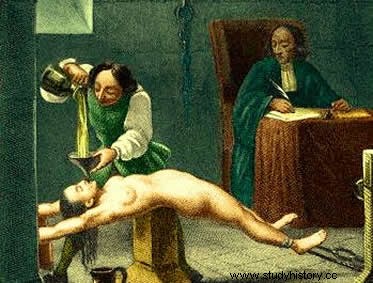
By Rainer Sousa
Between the Middle and Modern Ages, the Church stipulated the clear persecution against those who represented a threat to the hegemony of Catholic Christianity. To fulfill this mission, he stipulated the creation of the Court of the Holy Inquisition, which determined members of the Church to investigate possible suspects in the crime of heresy. Generally, the authority of the inquisitors was supported by government troops and the carrying out of processes that determined the guilt of the accused.
Often, even without a well-prepared body of evidence, a person could be accused of transgressing Catholicism and thus forced to appear in court. Generally, when the confession was not promptly declared, the conductors of the process stipulated the arrest of the accused. At that time, the possible heretic was subjected to terrible tortures that were intended to facilitate the confession of all the crimes of which he was accused.
For many of those who observed the practice of torture throughout the inquisition, it seems quite obvious to conclude that such practice simply manifested the disrespect and cruelty of the clerics involved with this institution. However, respecting the limits imposed by the time in which the inquisitors lived, we must see that these tortures also reflected theological conceptions that were taken for granted by those who used them.
The “colt” was one of the best known tortures in the cellars of the Holy Inquisition. In this method, the defendant was laid on a bed made of slats and had his limbs tied with ropes. Using a metal or wooden rod, the tied rope was wound until the accused was injured. Because of the welts and scars left by this type of torture, the inquisitors performed it a few weeks before the final conclusion of the process.
The most feared instrument of torture was the wheel. In this method, the victim had his body attached to the outside of a wheel positioned under a brazier. The tortured was suffering from the heat and the burns that formed as the wheel was moved towards the fire. In some versions, fire was replaced by pointed irons that lacerated the accused. The German and English inquisitors were the ones who most used this method of confession.
In the pendulum, the accused had his shins and wrists tied to ropes integrated into a pulley system. After that, his body was suspended up to a certain height, released and roughly held. The impact caused by this movement could dethrones the victim and, in some cases, leave them crippled. In a similar modality, called pole, the respondent was also tied up and had the extremities of his body violently stretched.
In a last modality of the series, we can highlight the use of the so-called “water torture”. In this torture device, the accused was strapped face up to a narrow table or easel. Unable to form the slightest reaction, the inquisitors inserted a funnel into the tortured's mouth and poured several liters of water down his throat. Sometimes a soaked cloth was introduced into the throat, causing shortness of breath.
Indeed, the terrors present in these methods of confession were abhorrent and horrified many people. However, the values and culture of that time allowed the observance of torture as a means of salvation for those who deviated from dogmas. Not by chance, many sessions were accompanied by doctors who made sure that the person would not die with the penalties used.
